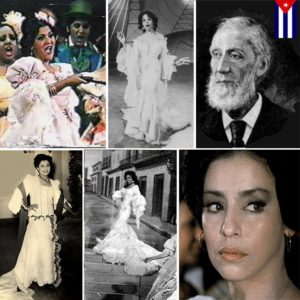 THE FIRST CUBAN NOVEL: “CECILIA VALDÉS”. VIDEOS.
THE FIRST CUBAN NOVEL: “CECILIA VALDÉS”. VIDEOS.
“Cecilia Valdés”, authored by Cirilo Villaverde, is a vivid description of the classes and political struggles of Cuba in the first half of the 19th century. It also constitutes the first antislavery novel and a lucid critique of the colonial regime and society of the time.
Cecilia Valdés or the loma del Ángel “is considered one of the most representative novels of the Cuban culture, both for its themes and its plot; likewise, it can be considered the first Cuban novel. In it Villaverde gathers the panorama of Cuban life from 1812 to 1831.
Allegory of the Creole woman, paradigm of the Cuban, romantic, realistic, popular, costumbrista, Cuban.
It is a novel in two volumes, and the first was published by the literary press of Lino Valdés in the middle of 1839. The complete work would be published in New York in 1879; and, already in its definitive version, in the same city in 1882.
Who does not remember what … “I am Cecilia, Cecilia Valdés” …?
Inspired by the novel and composed by Gonzalo Roig, it is a zarzuela that has also become a symbol of Cuban music thanks to its music. Many Cubans know her through this theatrical adaptation of Agustín Rodríguez and José Sánchez Arcilla, admirably played by Roig; version that was necessarily vertebrate with the story of the protagonists. Stripped of the descriptive luxury of its environment, the subject is flimsy and melodramatic. This applauded adaptation confirms that the fundamental thing in Cecilia Valdés is the environment. Its costumbrismo, of vigorous political, social and economic investigation, is the one that attenuates its defects and locates to the work in the doors of the realistic novelística.
The zarzuela “Cecilia Valdés” is considered throughout the world as the most representative Cuban zarzuela. Like the novel by Cirilo Villaverde, this piece of music is considered a characteristic element of national identity and, consequently, with the novel, zarzuela unifies us in the search for our national authenticity.
Like the novel, the zarzuela “Cecilia Valdés” is considered as the first of its kind, entirely Cuban, where the lyric reinforces the dramatic elements of the work, the romanticism of the theme and colonial costumbrismo.
Both are marked by a tragic or at least unfortunate destiny. The work unfolds in colonial Havana, around 1830.
The director Humberto Solás, took it to the cinema in 1982. With impressive staging, good management of narrative resources and acting direction, including extras, was a film not well understood by a part of the public and also by critics a specialist who attacked her tirelessly and did not see with good eyes the director’s need to freely express himself before a classic of literature, and why not, of Cuban theater.
Apart from all the fame, Cecilia Valdés, the beautiful mulatto woman who provoked the most passionate passions, rests today in a ruined sepulcher of the largest necropolis of the city. A strange fascination invades, however, those who arrive there. Attracted by the legend, they revive in a certain way the spirit of Cecilia, eternalized in the pages of a novel.
But she is still the sensual, mischievous and captivating mulata, courted by all men. Natural and voluptuous beauty that, with the passage of time, in the national imaginary of the island, will be used again and again as an allegory of the Creole woman, paradigm of the Cuban, romantic, realist, popular, local, Cuban.
Remain in the memory of readers for almost two centuries, can only be a result of a talent that exceeds any formal oversight, to settle in the soul of a nation.
 LA PRIMERA NOVELA CUBANA: “CECILIA VALDÉS”. VIDEOS.
LA PRIMERA NOVELA CUBANA: “CECILIA VALDÉS”. VIDEOS.
“Cecilia Valdés”, una autoría de Cirilo Villaverde, es una vívida descripción de las clases y las luchas políticas de Cuba en la primera mitad del siglo XIX. Constituye, asimismo, la primera novela antiesclavista y una lúcida crítica del régimen colonial y de la sociedad de la época.
Cecilia Valdés o la loma del Ángel” es considerada como una de las novelas más representativas de la cubanía tanto por sus temas como por su argumento; asimismo, se puede considerar la primera novela cubana. En ella Villaverde recoge el panorama de la vida cubana desde 1812 hasta 1831.
Alegoría de la mujer criolla, paradigma de lo cubano, romántica, realista, popular, costumbrista, cubana.
Es una novela en dos tomos, y el primero fue publicado por la imprenta literaria de Lino Valdés a mediados de 1839. La obra completa se publicaría en Nueva York en 1879; y, ya en su versión definitiva, en la misma ciudad en 1882.
¿Quién no recuerda lo de… ”Yo soy Cecilia, Cecilia Valdés”…?
Inspirado en la novela y compuesta por Gonzalo Roig es una zarzuela que también se ha convertido en símbolo de cubanía gracias a su música. Muchos cubanos la conocen a través de esa adaptación teatral de Agustín Rodríguez y José Sánchez Arcilla, musicalizada admirablemente por Roig; versión que necesariamente fue vertebrada con la historia de los protagonistas. Despojado del lujo descriptivo de su ambiente, el asunto resulta endeble y melodramático. Esta aplaudida adaptación confirma que lo fundamental en Cecilia Valdés es el ambiente. Su costumbrismo, de vigorosa indagación política, social y económica, es el que atenúa sus defectos y sitúa a la obra en las puertas de la novelística realista.
La zarzuela “Cecilia Valdés” está considerada en todo el mundo como la zarzuela cubana más representativa. Al igual que la novela de Cirilo Villaverde esta pieza musical está considerada como un elemento característico de la identidad nacional y en consecuencia con la novela, la zarzuela nos unifica en la búsqueda de nuestra autenticidad nacional.
Al igual que la novela, la zarzuela “Cecilia Valdés” está considerada como la primera en su tipo, enteramente cubana, donde la lírica refuerza los elementos dramáticos de la obra, el romanticismo del tema y el costumbrismo colonial.
Ambas están marcadas por un destino trágico o al menos infortunado. La obra se desenvuelve en La Habana colonial, hacia el 1830.
El director Humberto Solás, la llevó al cine en 1982. Con impresionante puesta en escena, buen manejo de los recursos narrativos y la dirección actoral, incluso de los extras, fue una película no bien comprendida por una parte del público y también de la crítica especializada que la atacó sin descanso y no vio con buenos ojos la necesidad del director de expresarse libremente ante un clásico de la literatura, y por qué no, del teatro cubano.
Al margen de toda la fama, Cecilia Valdés, la mulata hermosa que provocara las más encendidas pasiones, reposa hoy en un ruinoso sepulcro de la más grande necrópolis de la ciudad. Un extraño fascinación invade, sin embargo, a los que hasta allí llegan. Atraídos por la leyenda, reviven de cierta forma el espíritu de Cecilia, eternizado en las páginas de una novela.
Pero ella sigue siendo la mulata sensual, pícara y cautivadora, cortejada por todos los hombres. Beldad natural y voluptuosa a la que, con el paso del tiempo, en el imaginario nacional isleño, se recurrirá una y otra vez como alegoría de la mujer criolla, paradigma de lo cubano, romántica, realista, popular, costumbrista, cubana.
Permanecer en la memoria de los lectores durante casi dos siglos, sólo puede ser consecuencia de un talento que sobrepasa cualquier descuido formal, para instalarse en el alma de una nación.
Agencies/Memorias Cubanas/Derubín Jácome/ Internet Photos/You Tube/ Arnoldo Varona/ TheCubanHistory.com
THE CUBAN HISTORY, HOLLYWOOD.







